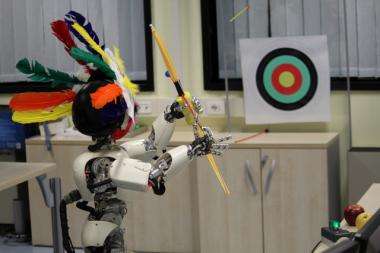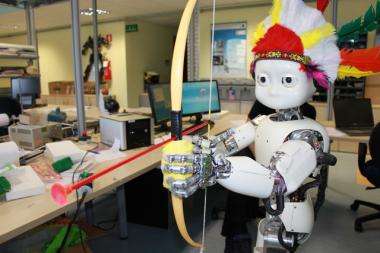Humanoid robot iCub learns the skill of archery. The learning algorithm, called ARCHER (Augmented Reward Chained Regression) algorithm, was developed and optimized specifically for problems like the archery training. Photo: Dr. Petar Kormushev
(PhysOrg.com) -- The humanoid robot iCub has learned a new skill: archery. After being taught how to hold a bow and shoot an arrow, it learned for itself how to improve its aim, and was so successful it could hit a bullseye after only eight trials.
The algorithm used to teach iCub is called the Augmented Reward Chained Regression (or ARCHER, naturally), and was developed especially for problems with specific knowledge about the goal to be achieved and which have a "smooth solution space." In archery, the greatest reward comes from hitting a bullseye, the center of the target.
Humanoid robot iCub learns the skill of archery.
The iCub robot is an open-source robotic platform about the same size as a child three and a half years old, or around 104 cm tall. It has 53 degrees of freedom (hence it is called the 53-DOF iCub) distributed about the head, torso, arms, legs, and hands. The distance between the target and the iCub was 3.5 meters.
The robot's hands were set manually to allow it to grip the bow, and one joint in the index finger was used to release the string and shoot the arrow. The algorithm controlled the posture of the left arm and the orientation of the right arm (string side).
ARCHER is a chained vector regression algorithm that uses experience gained from each trial to fine-tune the next attempt by modulating and coordinating the movements of the robot's hands. Movements of the arms are controlled by an inverse kinematics controller. After each shot a camera takes a picture of the target and an image recognition system based on Gaussian Mixture Models determines where the tip of the arrow hit the target by filtering the colored pixels of the picture based on their likelihood of belonging to the target or the arrow head. This information is then used as feedback for the algorithm.
Photo credits: Dr. Petar Kormushev
The algorithm was developed by Dr. Petar Kormushev and colleagues of the Italian Institute of Technology (IIT). The results of the research will be presented in December this year at the Humanoids 2010 conference in Nashville TN in the US.
More information: Research paper: kormushev.com/papers/Kormushev_Humanoids-2010.pdf
© 2010 PhysOrg.com

























